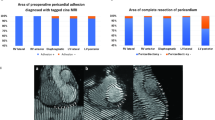Abstract
Background
The purpose of this study was to evaluate findings at abdominal computed tomography (CT) in patients with proven constrictive pericarditis.
Methods
The medical records of 25 patients with surgically proven constrictive pericarditis and abdominal CT examinations within 30 days of operation were reviewed. Clinical symptoms, laboratory findings and prospective CT findings were collated. The CT examinations were also retrospectively reviewed in an unblinded fashion.
Results
Direct CT findings of constrictive pericarditis with an abnormal pericardium were present in 23/25 patients. Only 9 of 25 (36%) patients were detected prospectively. Findings on retrospective review included pericardial calcification (10/25, 40%) or thickening (13/25, 52%), dilated IVC (20/25), dilated hepatic veins (14/25), ascites (14/25), mesenteric soft tissue stranding (12/25), mottled enhancement of the hepatic parenchyma (8/25), and cirrhosis (6/25). Anemia was present in (17/25), and an elevated AST levels occurred in 48% (12/25) of patients. The most common abdominal symptoms were pain (4/12), diarrhea (4/12), distention (3/12), and bloating (1/12).
Conclusions
Constrictive pericarditis can present with vague abdominal symptoms. Anemia and elevated liver function tests are common laboratory abnormalities. Indirect CT findings of dilated IVC and/or hepatic veins, ascites, or cirrhosis should prompt inspection of the pericardium. In the majority of cases an abnormal pericardium could be identified (thickened, calcified or both).





Similar content being viewed by others
References
Pericarditis. In: http://www.medicinenet.com/pericarditis/article.htm., April 24, 2002
Van der Merwe S, Dens J, Daenen W, et al. (2000) Pericardial disease is often not recognized as a cause of chronic severe ascites. J Hepatol 32(1):164–169
De Benedetti E, Didier D (2000) Images in clinical medicine. Constrictive pericarditis. N Engl J Med 343(2):107
Glockner JF (2003) Imaging of pericardial disease. Magn Reson Imaging Clin N Am 11(1):149–162
Karia DH, Xing YO, Kuvin JT, et al. (2002) Recent role of imaging in the diagnosis of pericardial disease (review). Curr Cardiol Rep 4(1):33–40
Wang ZJ, Reddy GP, Gotway MB, et al. (2003) CT and MR imaging of pericardial disease. RadioGraphics 23:S167–S180
Talreja DR, Edwards WD, Danielson GK, et al. (2003) Constrictive pericarditis in 26 patients with histologically normal pericardial thickness. Circulation 108(15):1852–1857
Acknowledgments
The authors of this paper would like to thank Ms. Debora Shreve for her help preparing this manuscript for publication.
Author information
Authors and Affiliations
Corresponding author
Rights and permissions
About this article
Cite this article
Johnson, K.T., Julsrud, P.R. & Johnson, C.D. Constrictive pericarditis at abdominal CT: a commonly overlooked diagnosis. Abdom Imaging 33, 349–352 (2008). https://doi.org/10.1007/s00261-007-9246-9
Published:
Issue Date:
DOI: https://doi.org/10.1007/s00261-007-9246-9




